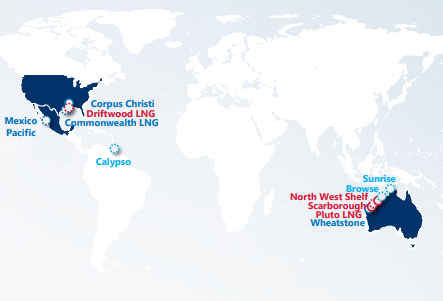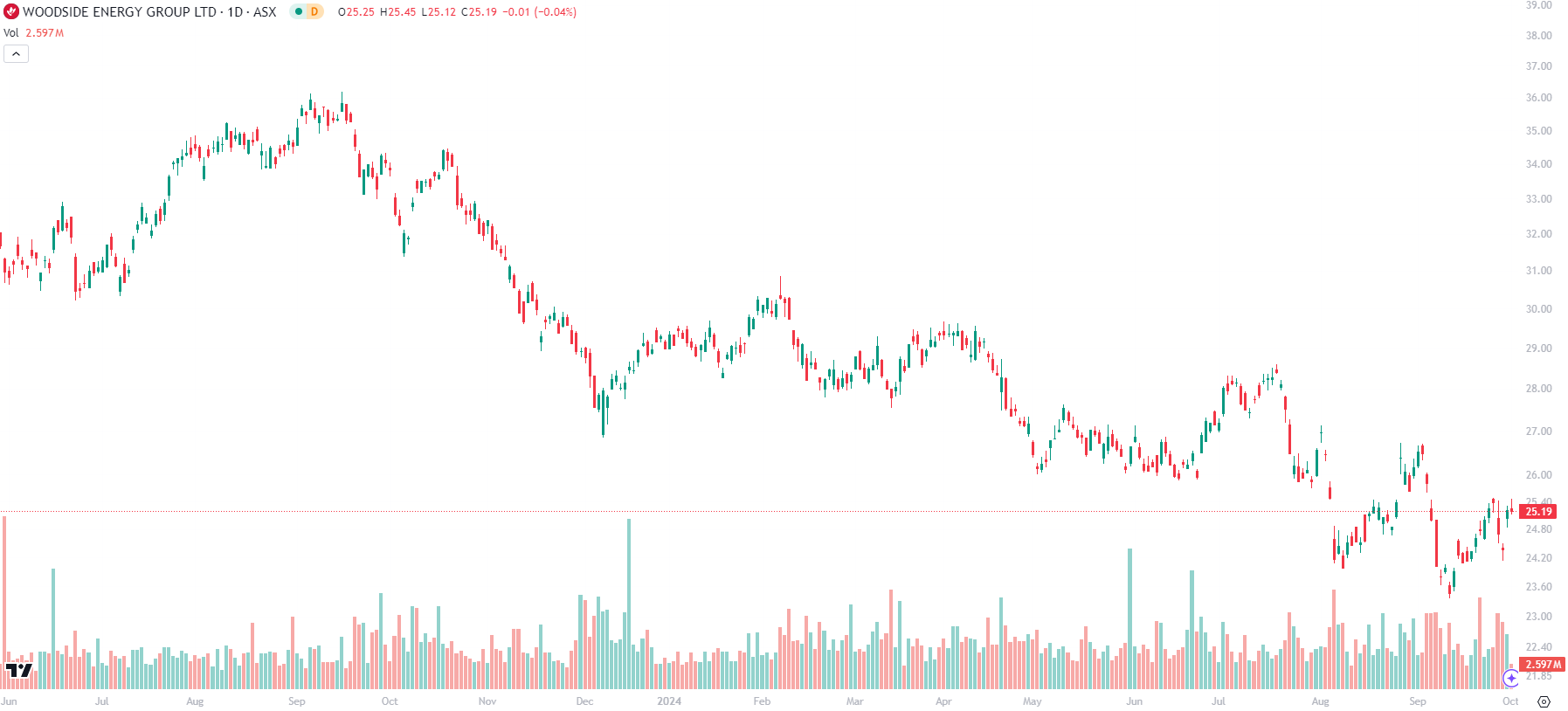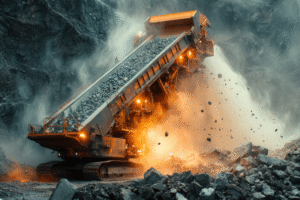Woodside Energy (ASX:WDS): Oil and gas isn’t dead just yet, but where does this energy giant’s future lie
![]() Nick Sundich, October 2, 2024
Nick Sundich, October 2, 2024
Woodside Energy (ASX:WDS) is the ASX’s largest energy company, capped at nearly $50bn. A traditional oil and gas giant, a large player in the LNG, many would perceive it is part of the problem that increased carbon emissions represent and that the planet would be better off without it. Whether or not that is the case, the company wants you to believe it is part of the solution. But is it?
Overview of Woodside Energy
Woodside began 70 years ago, in 1954, named after the Victorian town where it first began drilling for oil. Today it is a global company with its headquarters and the bulk of its major assets in Western Australia, along with assets in Trinidad & Tobago and in American waters in the Gulf of Mexico. In 2022, it merged its petroleum business with that of BHP. Since 1989, Woodside has been in LNG (Liquidifed Natural Gas) and its flagship LNG project has been Pluto, which consists of oil fields off the coast of WA and an onshore processing facility near Karratha with a gross capacity of 4Mtpa and annual production over 46MMboe. It also has a minority stake in North West Shelf Project which has a capacity of 16.9Mtpa and 33MMboe LNG production.
Woodside also owns the Scarborough LNG project which will be Australia’s biggest oil and gas project for at least a decade, expected to produce 9m tonnes of LNG annually when it enters production. The oil field has proved plus probably reserves of 1,810MMboe and Woodside retains a majority stake for the time being. Specifically it owns 74.9% with 15.1% owned by Japan’s JERA following its February 2024 acquisition of that share for A$1.4bn and another 10% belongs to LNG Japan, which paid $500m in August 2023.

Source: Company
Why is Japan so interested in LNG? Well it is the world’s second biggest LNG importer, as it relies on LNG for a third of its electricity mix. Scarborough has taken such a long time to get off the ground, but first production is scheduled for 2026 – a target date that has not shifted for some time. The company has told investors it is 67% complete.
Among other projects, its Trion project in the Gulf of Mexico is 10% complete an on track for first oil in 2028, while its Sangomar oil field off the coast of Senegal began production in June 2024. Overall, the company expects to produce over 500,000 barrels of oil equivalent per day. Its most recent dividend represents a yield of 7.3%. And finally, it boasts to have 98% LNG reliability across its operational assets.
The company boasts that there is strong demand for LNG going forward. Australia is already one of the world’s largest exporters and demand has grown by over 60% in the last decade. Over the next decade, demand is expected to grow by another 50%, and indeed, most contracts secured in the global market have been for over a decade. Australia is well positioned to service the markets that demand LNG the most, particularly markets with Asia.
Is Woodside part of the solution or part of the problem?
Woodside is not one of those commodities companies that is pivoting away from its roots for the sake of the planet. It is doubling down on gas, given its persistence with Scarborough LNG project despite significant costs and environmental opposition. During the summer of 2023-24, Woodside attempted to merge with Santos, a move that would’ve created an $80bn company, although the talks ended with no one getting except both companies’ corporate advisors who got a sweet $28m. Clearly Woodside thinks it is part of the solution rather than the problem so far as reducing emissions are concerned? Is it?
Let’s look at LNG more generally. It has half the lifecycle emissions of coal to begin with, and emissions can be even lower dependant on technology. It is very mobile, seasonally adaptable and can fit into existing natural gas networks. Woodside thinks LNG may play a big part in replacing coal, which accounts for a quarter of the world’s energy consumption according to the Energy Institute. In fact, it reckons LNG is playing a role already with the largest driver in emissions reductions in the US was switching form coal to gas. Some countries rely more heavier on coal, China for instance relies on coal for over 60%, but it is expected to turn to natural gas as part of decarbonisation efforts. It used 390bcm in 2023, but S&P thinks demand will reach 605bcm in 2040. If only 12% of coal-fired power generation was converted to LNG today, it would double the current global market. If more than that…use your imagination.
But ultimately, Scarborough will still generate some emissions (880 million according to its own development proposal). A good run in the oil price in the aftermath of Russia’s invasion of Ukraine masked the fact that oil and gas is on the way out in the long-term. From an ESG standpoint, Woodside is on track to cut its direct emissions by 15% by 2025, although this is not good enough for some investors.
Whatever you think of Woodside’s ESG credentials, think about its financials
Woodside’s profit for CY23 came in 37% lower, dragged down by lower oil prices, and consensus estimates suggest the highs of CY22 are not returning. Things have not improved much so far in CY24 with its revenue and profit for 1HY24 coming in 19% and 14% lower respectively. The company has boasted that it has a strong focus on costs and has kept them under control despite inflationary pressures. All well and good, but not enough to prevent margins falling.
Woodside shares are down 30% over the last year at the same time the ASX 200 gained 17%. So it seems investors are skeptical. Analysts covering the company have mean target price of A$29.73, an 18% premium to the current share price. Nonetheless, they call for a 10% decrease in revenue in CY24, then a stagnation for CY25 and CY26 with a return to CY23 levels in CY27. Consensus estimates place the company at 14.5x P/E, not unreasonable for a A$50bn company.

Woodside Energy (ASX:WDS) share price chart, log scale (Source: TradingView)
Conclusion
The risk of commodity price fluctuation is a risk you face with any company in the commodity space. Woodside is no different in that regard. If it can get Scarborough into production successfully and the demand for LNG is what Woodside and economists claim it will be, the current market cap will seem like a bargain in the years to come. But…this is an if. Moreover, it remains to be seen if it can continue to keep cost inflation under control and how prices will go. We’d hold off on any investment in Woodside until CY26, when it will have Scarborough in production.
What are the Best ASX Stocks to invest in right now?
Check our buy/sell tips
Blog Categories
Get Our Top 5 ASX Stocks for FY26
Recent Posts
Larvotto Resources is fully funded for its $694M Hillgrove Project
18% Jump for Larvotto Resources as Hillgrove Construction Moves Ahead, Backed by $175M in New Funding Larvotto Resources (ASX: LRV)…
Archer Materials Cracks Quantum Readout Challenge as Stock Surges 12%
Archer Materials Just Solved One of Quantum Computing’s Hardest Problems Archer Materials (ASX: AXE) jumped 12% today after unveiling two…
NVIDIA’s Blackwell Chips Ignite Record Demand in Q3
NVIDIA’s Blackwell Surge Tech investors and growth-focused funds will be breathing a sigh of relief after NVIDIA (NASDAQ: NVDA) delivered…



